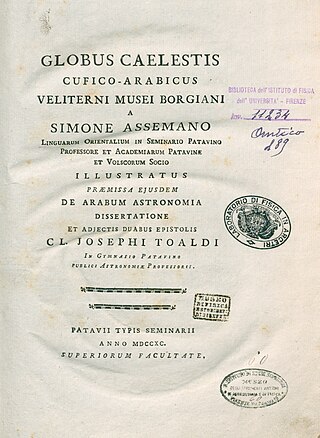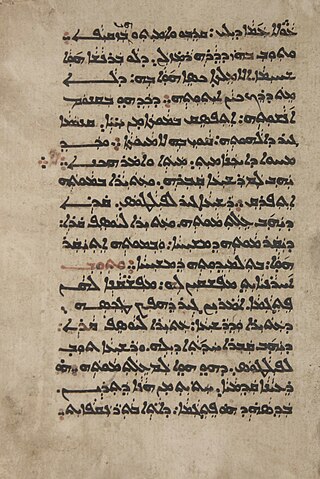Related Research Articles

Angelo Maria Bandini was an Italian author and librarian born in Florence.

Jacob of Serugh, also called Mar Jacob, was one of the foremost Syriac poet-theologians, perhaps only second in stature to Ephrem the Syrian and equal to Narsai. Where his predecessor Ephrem is known as the 'Harp of the Holy Spirit', Jacob is the 'Flute of the Holy Spirit' in Antiochene Syriac Christianity. He is known primarily for his prodigious corpus of more than seven-hundred verse homilies, or mêmrê, of which only 225 have been edited and published.
Gregory Bar Hebraeus, known by his Syriac ancestral surname as Barebraya or Barebroyo, in Arabic sources by his kunya Abu'l-Faraj, and his Latinized name Abulpharagius in the Latin West, was a Maphrian of the Syriac Orthodox Church from 1264 to 1286. He was a prominent writer, who created various works in the fields of Christian theology, philosophy, history, linguistics, and poetry. For his contributions to the development of Syriac literature, has been praised as one of the most learned and versatile writers among Syriac Orthodox Christians.

The Biblioteca Ambrosiana is a historic library in Milan, Italy, also housing the Pinacoteca Ambrosiana, the Ambrosian art gallery. Named after Ambrose, the patron saint of Milan, it was founded in 1609 by Cardinal Federico Borromeo, whose agents scoured Western Europe and even Greece and Syria for books and manuscripts. Some major acquisitions of complete libraries were the manuscripts of the Benedictine monastery of Bobbio (1606) and the library of the Paduan Vincenzo Pinelli, whose more than 800 manuscripts filled 70 cases when they were sent to Milan and included the famous Iliad, the Ilias Picta.

The Peshitta is the standard version of the Bible for churches in the Syriac tradition, including the Maronite Church, the Chaldean Catholic Church, the Syriac Catholic Church, the Syriac Orthodox Church, the Malankara Orthodox Syrian Church, the Malabar Independent Syrian Church, the Syro-Malankara Catholic Church, the Assyrian Church of the East and the Syro-Malabar Church.

Giuseppe Simone Assemani (Classical Syriac : ܝܵܘܣܸܦ ܒܲܪ ܫܸܡܥܘܿܢ, was a librarian, Lebanese Maronite orientalist, and Catholic bishop. For his efforts, and his encyclopedic knowledge, he earned the nickname "The Great Assemani".
Giuseppe Luigi Assemani was a Lebanese Catholic priest, an orientalist and a Professor of Oriental languages in Rome.

Simone Assemani, grand-nephew of Giuseppe Simone Assemani, was born in Rome.
The Cave of Treasures, sometimes referred to simply as The Treasure, is an apocryphal and pseudoepigraphical work, that contains various narratives related to the Christian Bible. It was written in the Syriac language, approximately at the end of the 6th, or at the beginning of the 7th century. Its authorship was traditionally attributed to Ephrem of Edessa, but modern scholarly analyses have shown that the true author was some other person, who also lived in Upper Mesopotamia, but much later.
Moses bar Kepha or Moses bar Cephas was a writer and one of the most celebrated bishops of the Syriac Orthodox Church of the ninth century.
Codex Assemanius is a rounded Glagolitic Old Church Slavonic canon evangeliary consisting of 158 illuminated parchment folios, dated to early 11th century. The manuscript is created in the Ohrid Literary School of the First Bulgarian Empire.

Andreas Birch was a professor from Copenhagen. Birch was sent in 1781–1783 by the king of Denmark, Christian VII, to examine manuscripts in Italy, Germany, and other European countries.

The patriarch of the Church of the East is the patriarch, or leader and head bishop of the Church of the East. The position dates to the early centuries of Christianity within the Sassanid Empire, and the Church has been known by a variety of names, including the Church of the East, Nestorian Church, the Persian Church, the Sassanid Church, or East Syrian.

Mar Shemʿon VII Ishoʿyahb, born Īshōʿyahb bar Māmā, was Patriarch of the Church of the East from 1539 to 1558, with residence in Rabban Hormizd Monastery.
The schism of 1552 was an important event in the history of the Church of the East. It divided the church into two factions, of which one entered into communion with Rome becoming part of the Catholic Church at this time and the other remained independent until the 19th century. Although the Eliya line, which emerged as a result of this schism, did eventually enter into communion with Rome, various Eastern Protestant sects with their origins in the Church of the East emerged as a result of this schism. The Shimon line whose entry into full communion with Rome caused this schism became independent again by the 17th century. The circumstances of the 1552 schism were controversial at the time and have been disputed ever since.
Sarkis Rizzi, or Sarkis el-Rizzi was a Lebanese Maronite bishop. On his initiative, he was the first clergyman to print of a book in an Arab country.

The Chronicle of Edessa is an anonymous history of the city of Edessa written in the mid-6th century in the Syriac language. "Chronicle of Edessa" is a conventional title; in the manuscript it is titled Histories of Events in Brief.

Yoḥannan bar Zoʿbi, commonly Rabban Yoḥannan and sometimes anglicized John bar Zobi, was a monk, grammarian, philosopher, theologian and liturgist of the Church of the East who wrote in Syriac.
Nuhrā d-Tešmeštā ʿEdtānāytā, better known by its Latin title, Expositio officiorum ecclesiae, is an anonymous Syriac commentary on the East Syriac liturgy. Its author is usually referred to as Pseudo-George of Arbela. The work is dedicated to a certain Daniel.
References
- This article incorporates text from a publication now in the public domain : Chisholm, Hugh, ed. (1911). "Assemani". Encyclopædia Britannica . Vol. 2 (11th ed.). Cambridge University Press. p. 779.
- Herbermann, Charles, ed. (1913). . Catholic Encyclopedia . New York: Robert Appleton Company.
- Giorgio Levi della Vida, «ASSEMANI, Stefano Evodio». In: Dizionario Biografico degli Italiani , Volume IV, Rome: Istituto dell'Enciclopedia Italiana, 1962